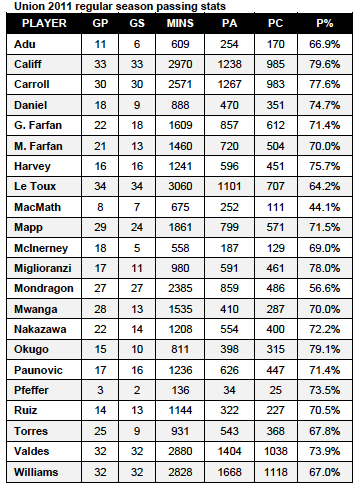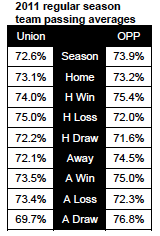Featured image: Paul Rudderow
When I was gathering the season stats for all of the Philadelphia Union players to share with the PSP writers for our forthcoming 2011 season review series I realized no passing stats were available, either for the club or for individual players. Actually, that’s not precisely true; you can find passing percentages for the team on a game-by-game basis by clicking on the Stat tab for each game’s MatchCenter page at MLSsoccer.com. You can do the same for each player by clicking on the Chalkboard tab for each game. But in both cases you’ll need to do a bit more work. The Chalkboard provides the raw data of successful and unsuccessful passes but does not provide a passing accuracy percentage. And for both the team and individual player stats, you need to collect all of the info on a game-by game basis yourself before you can determine the season averages.
Well, this writer recently recently had the potent combination of time, calculator, and healthy obsession to do the figuring for you. The chart below shows passes attempted, passes completed and the passing accuracy percentage for Union players as recorded in the Chalkboard tab on the MatchCenter page for each regular season game in 2011.
 Union players regular season passing stats
Union players regular season passing stats
The top five highest passing percentages among Philadelphia Union players were Danny Califf (79.6%), Amobi Okugo (79.1%), Stefani Miglioranzi (78%), Brian Carroll (77.6%) and Jordan Harvey (75.7%), all of whom had ten or more starts in 2011, and all of whom are defenders or defensive midfielders.
Among field players by position, Sheanon Williams had the lowest passing accuracy percentage of the defenders (67.0%), which is understandable when you think of how many crosses he delivers. For those who still bemoan the departure of Jordan Harvey, it should be noted that Gabriel Farfan’s passing numbers include games in which he played as a midfielder. Looking at only those games in which he played as a defender, his passing accuracy rises to 72.2 percent. Overall, the defense combined for a passing accuracy average of 73.5 percent.
Freddy Adu (66.9%), with 11 appearances and six starts, had the lowest passing accuracy percentage among midfielders, followed by Roger Torres (67.8%), who had 25 appearances and nine starts. Overall, the midfield combined for a passing accuracy average of 73.1 percent.
Among players listed as forwards, Veljko Paunovic (71.4%) had the highest passing accuracy percentage followed by Carlos Ruiz (70.5%) and Danny Mwanga (70.0%). Sebastien Le Toux (64.2%) had the lowest passing accuracy percentage. Overall, the forwards combined for a passing accuracy average of 69.0 percent.
The Union goalkeepers combined averaged 50.4 percent accuracy, with Faryd Mondragon at 56.6 percent over 27 appearances and Zac MacMath at 44.1 percent over eight appearances.
The overall combined average of the players’ passing accuracy averages comes to 70.2 percent with the goalkeepers, 72.2 percent without the goalkeepers.
Team regular season passing stats
The chart to the right is derived from the stats page at the MatchCenter for each of the Union’s regular season games at MLSsoccer.com. Looking at the team’s overall passing accuracy, the Union average 72.6 percent accuracy versus 73.9 percent for their opponents. The Union’s passing accuracy average at home was slightly better at 73.1 percent than their overall average but was still below that of their opponents.
Interestingly, the Union’s highest passing accuracy average, 75.0 percent, came from losses at home. The next highest average was home wins (74%) followed by away wins (73.5%). On average, the Union enjoyed higher passing accuracy than their opponents in home losses, home draws, and away losses. The category with the greatest difference in passing accuracy was away draws. In that category, the Union averaged 69.7 percent passing accuracy compared to 76.8 percent accuracy for their opponents.
Our season review series featuring every Union player, including those that left the club during or after the season, starts on Monday, Dec. 5. You can click here to see the installments from last year’s review series.


can we get a further break down with forward and backwards passing?
There’s a basic tenet uncovered in basketball analytics: the inverse relationship between a player’s usage and efficiency. Usage is effectively how often a player is involved in the offense (shots taken); efficiency can be measured by field goal percentage.
As a player becomes more involved in a team’s offense, his efficiency decreases. This is sort of a ballhog effect: if a player is the focal point of an offense then the defense can key on him and reduce his effectiveness. Players who don’t see the ball a lot get easy passes and shots.
But as I understand it, this relationship only holds up for individual players. When you look at all players in a league, the relationship reverses: good players (high usage) are better (higher efficiency). Obviously there are exceptions (Allen Iverson, Kobe Bryant are high usage, very low efficiency players) but the rule stands.
Applying this logic to these data, if we measure efficiency by pass completion and usage by passes attempt rate (passes per 90 minutes), the relationship is very slightly positive.
http://dl.dropbox.com/u/5706159/Union%20Usage%20vs.%20Efficiency.png
At the top right of the graph, the Union player with the highest usage and a very high efficiency: Stefani Miglioranzi.
Nice work on the graph, Rolando. When I collected the data, I was disappointed that I didn’t have anything to compare it to – other players, other teams, other leagues. You making the basketball comparison is very helpful. For myself, I never really paid attention to statistics before I started compiling them for PSP articles. Thanks again for the graph – get in touch if you’d like to write at length about your conclusions.
You have my email (I think). I’d definitely be interested in looking at the data. Here’s something I wrote yesterday. http://bit.ly/sOwzXg
BTW, thanks for taking the time to compile this data. MLS is really doing itself a disservice by not making this more easily available.